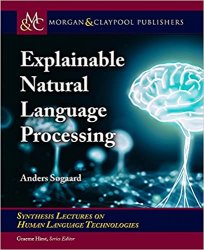 Название: Explainable Natural Language Processing
Название: Explainable Natural Language ProcessingАвтор: Anders Søgaard
Издательство: Morgan & Claypool
Год: 2021
Страниц: 124
Язык: английский
Формат: pdf (true)
Размер: 10.2 MB
This book presents a taxonomy framework and survey of methods relevant to explaining the decisions and analyzing the inner workings of Natural Language Processing (NLP) models. The book is intended to provide a snapshot of Explainable NLP, though the field continues to rapidly grow. The book is intended to be both readable by first-year M.Sc. students and interesting to an expert audience. The book opens by motivating a focus on providing a consistent taxonomy, pointing out inconsistencies and redundancies in previous taxonomies. It goes on to present (i) a taxonomy or framework for thinking about how approaches to explainable NLP relate to one another; (ii) brief surveys of each of the classes in the taxonomy, with a focus on methods that are relevant for NLP; and (iii) a discussion of the inherent limitations of some classes of methods, as well as how to best evaluate them. Finally, the book closes by providing a list of resources for further research on explainability.
Explainable Natural Language Processing (NLP) is a new subfield of NLP, only really taking off within the last four or five years. Whenever a new subfield of a scientific discipline emerges, it almost by definition attracts a mixed crowd of researchers from related, but different subfields. These researchers of course do not yet form a consolidated network and also typically bring slightly different traditions, languages, and protocols from their respective subfields. This, undoubtedly, leads to a lot of redundancy: researchers presenting what is essentially the same, in radically different ways; researchers reinventing what they did not know already existed; and
researchers proposing new models that only in the absence of established evaluation protocols, seem superior to existing ones. This book first and foremost presents a taxonomy of approaches to explainable (neural) NLP. I present this taxonomy with the noble, yet perhaps not so humble, goal of accelerating progress in this emerging subfield.
There exists a wide range of libraries and code bases for explainability methods already, but many of them overlap in what they cover. Here is a list of libraries that I have used or that seemed relevant to me, with a slight bias toward Python, and trying to avoid too much overlap. I apologize in advance for all the amazing toolkits I left out:
ACE. Tensorflow code for Ghorbani et al.
AIX360. Python library with implementations of LIME.
Alibi Explain. Python toolkit for integrated gradients, contrastive, and counterfactual explanations.
AllenInterpret. Library built on top of AllenNLP, with a focus on gradient-based saliency maps and adversarial attacks.
BertViz. BertViz is a popular visualization tool for attention (Chapter 5) in language models.
Captum.ai. The PyTorch library Captum is available at https://captum.ai/ and supports integrated gradients for most neural architectures relevant to NLP.
Dalex. Library for interpretability, bias, and fairness, described in Biecek; includes LIME.
Darkon. Library for influence functions and gradience-based explanations.
DeepLift. Keras/Tensorflow implementation of DeepLift.
DiCE. Code base for counterfactual explanations.
Lucid. Tensorflow library for compositing interfaces combining multiple explanation methods...
Скачать Explainable Natural Language Processing